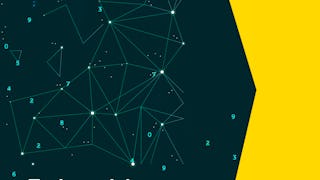This course provides an introduction to econometrics, focusing on its scope, foundational concepts, and practical applications in analyzing economic relationships. Learners will begin by exploring the distinctions between economic models and econometric models, gaining an understanding of how theory and data intersect in empirical research. The course introduces regression analysis, starting with simple linear regression involving one dependent and one independent variable, enabling students to examine the nature and strength of relationships between economic variables.


您将学到什么
Master the policy-making process, analyzing policy issues and stakeholder interests. Gain skills to assess policies and contribute to their creation.
您将获得的技能
要了解的详细信息

添加到您的领英档案
September 2025
27 项作业
了解顶级公司的员工如何掌握热门技能

该课程共有7个模块
In this module, you will learn about the scope of econometrics, economic models, and econometric models. You will then be introduced to regression analysis between one dependent variable and one independent variable. Further, you will revise the concepts of individual, conditional, and joint distributions and the concept of variable independence. Later, you will learn how to identify relationships between two variables. And lastly, you will explore the general nature of the linear regression model.
涵盖的内容
10个视频2篇阅读材料3个作业
In this module, you will learn about the theory and practice of simple linear regression with one dependent variable and one independent variable. Simple linear regression is a statistical method that allows us to summarize and study relationships between two variables and goes beyond exploring the simple correlation between them. You will first learn the estimation and interpretation of the estimators of a regression model. Then, you will be able to understand those estimators’ numerical and statistical properties. Lastly, you will work with some practical, functional forms to handle nonlinearities in regression models.
涵盖的内容
11个视频2篇阅读材料3个作业
In this module, you will move from the simple linear regression model with one regressor to the multiple linear regression model with two or more regressors. We use the adjective “simple” to denote that a model has only one regressor and the adjective “multiple” to indicate that a model has at least two regressors. In learning the practice of multiple linear regression, importance is accorded to building an intuitive understanding without using matrix algebra, mainly by analogy with simple linear regression. Lastly, you can derive and learn the algebraic properties of a regression model with k explanatory variables.
涵盖的内容
10个视频2篇阅读材料3个作业
In this module, you will continue with the multiple linear regression model and use that to learn statistical inference, allowing you to infer something about the population model from a random sample. The sixth assumption of the classical linear model is the additional assumption that the population error is normally distributed. In the model, you will understand the sample distributions of the OLS estimators. Further, you will be able to review how to carry out a hypothesis test, assuming the six assumptions are true. You will also be able to do several specifications of hypothesis testing, including restrictions on a single parameter, a combination of two parameters, exclusion restrictions, tests of overall significance, and multiple linear restrictions. To conclude, you will be using the t-statistic and F-statistic.
涵盖的内容
12个视频4篇阅读材料5个作业
In this module, you will continue with the multiple linear regression model and explore the asymptotic properties of the OLS estimators, which holds true when you transition from a small sample to a large sample. These properties are also known as the large sample properties. Post OLS asymptotics, you will learn about some extensions of the linear regression model, which are mostly used in applied work. You will further explore regression models, which are three different functional forms of explanatory models. Starting with the case when you have quadratic terms of the explanatory variable, you will discuss regression models with categorical explanatory variables. Finally, you will understand the regression models involving the interaction of explanatory variables as regressors.
涵盖的内容
8个视频4篇阅读材料5个作业
In this module, you will keep using the multiple linear regression model and analyze the standard linear regression model considering the three problems that crop up most frequently when analyzing cross-sectional data. You will learn, in particular, about the bias and inconsistency arising from omitting important variables, as well as the effects of multicollinearity and heteroscedasticity in your data. You will also learn how to identify multicollinearity and heteroscedasticity in your model, test for it, and correct it using various techniques.
涵盖的内容
8个视频3篇阅读材料4个作业
In this module, you will learn about data and specification errors commonly encountered in multiple linear models. You will also learn about the tests to check for model misspecification, using proxy as a possible solution for model misspecification. Further, you will be introduced to issues that crop due to measurement error in the dependent and independent variables. You will also gain an understanding of two advanced models. First is the binary response model, which is used when the dependent variable is binary in nature. Next, you will learn about the time series model. You will also get some insights into the problem of autocorrelation, which is usually encountered when we have specification errors in time series data.
涵盖的内容
11个视频3篇阅读材料4个作业
攻读学位
课程 是 O.P. Jindal Global University提供的以下学位课程的一部分。如果您被录取并注册,您已完成的课程可计入您的学位学习,您的学习进度也可随之转移。
位教师

从 Economics 浏览更多内容
 状态:免费
状态:免费Erasmus University Rotterdam
 状态:预览
状态:预览Erasmus University Rotterdam
 状态:预览
状态:预览O.P. Jindal Global University
 状态:免费试用
状态:免费试用Rice University
人们为什么选择 Coursera 来帮助自己实现职业发展




常见问题
To access the course materials, assignments and to earn a Certificate, you will need to purchase the Certificate experience when you enroll in a course. You can try a Free Trial instead, or apply for Financial Aid. The course may offer 'Full Course, No Certificate' instead. This option lets you see all course materials, submit required assessments, and get a final grade. This also means that you will not be able to purchase a Certificate experience.
When you purchase a Certificate you get access to all course materials, including graded assignments. Upon completing the course, your electronic Certificate will be added to your Accomplishments page - from there, you can print your Certificate or add it to your LinkedIn profile.
Yes. In select learning programs, you can apply for financial aid or a scholarship if you can’t afford the enrollment fee. If fin aid or scholarship is available for your learning program selection, you’ll find a link to apply on the description page.
更多问题
提供助学金,



